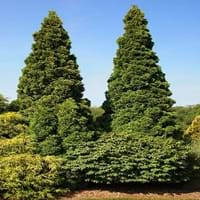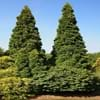Life Span
Perennial
Perennial
Type
Needled or Scaled Evergreen
Bulb or Corm or Tuber
Origin
Northeastern United States, Mid-Atlantic United States, Southeastern United States, North-Central United States, Central United States, Canada
South America, Argentina
Types
Not Available
Not Available
Habitat
Dry areas, Lake Sides, riparian zones, Slopes, Upland
Temperate Regions
USDA Hardiness Zone
3-7
5-9
Sunset Zone
A2, A3, H1, H2, 1a, 1b, 2a, 2b, 3a, 3b, 4, 5, 6, 7, 8, 9, 15, 16, 17, 21, 22, 23, 24
21,22
Habit
Pyramidal
Clump-Forming
Flower Color
Yellow, Yellow Brown
Light Blue, Light Purple, Silver, Sky Blue
Flower Color Modifier
Bicolor
Bicolor
Fruit Color
Brownish Red, Red
Not Available
Leaf Color in Spring
Green, Dark Green
Green, Light Green, Gray Green
Leaf Color in Summer
Green, Dark Green
Light Green
Leaf Color in Fall
Green, Dark Green
Several shades of Green
Leaf Color in Winter
Green, Dark Green, Brown
Light Green
Leaf Shape
Scale-like imbricate
Grass like
Plant Season
Spring, Summer, Fall, Winter
Spring
Sunlight
Full Sun, Partial Sun
Full Sun, Partial Sun, Partial shade
Growth Rate
Medium
Medium
Type of Soil
Loam, Sand
Clay, Loam, Sand
The pH of Soil
Acidic, Neutral
Acidic, Neutral, Alkaline
Soil Drainage
Average
Well drained
Bloom Time
Spring
Early Spring, Spring, Late Winter
Tolerances
Drought
Drought
Where to Plant?
Ground
Container, Ground
How to Plant?
Seedlings, Stem Cutting
By dividing rhizomes, tubers
Plant Maintenance
Medium
Medium
Watering Requirements
Drought Tolerant, Keep the ground moist but not water-logged, Requires regular watering
Average Water Needs, Do Not over Water, Requires regular watering
In Summer
Lots of watering
Lots of watering
In Spring
Moderate
Moderate
In Winter
Average Water
Average Water
Soil pH
Acidic, Neutral
Acidic, Neutral, Alkaline
Soil Type
Loam, Sand
Clay, Loam, Sand
Soil Drainage Capacity
Average
Well drained
Sun Exposure
Full Sun, Partial Sun
Full Sun, Partial Sun, Partial shade
Pruning
Remove damaged leaves, Remove dead branches, Remove dead leaves
Remove damaged leaves, Remove dead branches, Remove dead leaves
Fertilizers
All-Purpose Liquid Fertilizer
All-Purpose Liquid Fertilizer
Pests and Diseases
Citrus leaf miner, Drought, Edema, Gray mold
Slugs, Snails
Plant Tolerance
Drought
Drought
Flower Petal Number
Single
Single
Fragrant Bark/Stem
Yes
No
Foliage Texture
Medium
Medium
Foliage Sheen
Glossy
Matte
Attracts
Birds
Bees, Birds, Hummingbirds
Allergy
Anaphylaxis, Hives, Itchy eyes, Red eyes, Runny nose, Skin rash, sneezing, Watery eyes
Not Available
Aesthetic Uses
Showy Purposes
Showy Purposes
Beauty Benefits
Not Available
Not Available
Environmental Uses
Air purification
Air purification
Medicinal Uses
anti rheumatic, Astringent, Diuretic, Expectorant, Tonic
No Medicinal Use
Part of Plant Used
Bark, extracted oil, Leaves, Twigs
Flowers
Other Uses
Medicinal oil, Used as firewood, Used in herbal medicines, Used in Homeopathy
Not Available
Used As Indoor Plant
No
Yes
Used As Outdoor Plant
Yes
Yes
Garden Design
Feature Plant, Foundation, Hedges, Mixed Border, Screening, Wind Break
Container, Lawns and Turf, Mixed Border, Rock Garden / Wall, Wildflower
Botanical Name
THUJA occidentalis
Ipheion uniflorum
Common Name
northern white cedar, swamp cedar, false white ceda
Spring Starflower, Springstar
In Hindi
Thuja occidentalis
Spring Starflower
In German
Abendländischer Lebensbaum
Frühling Borretsch
In French
Thuya occidental
Spring Starflower
In Spanish
Tuya del Canadá
primavera Flor de estrella
In Greek
Thuja occidentalis
άνοιξη starflower
In Portuguese
Thuja occidentalis
primavera Starflower
In Polish
Żywotnik_zachodni
Wiosna Starflower
In Latin
Thuja occidentalis
Spring Starflower
Phylum
Tracheophyta
Magnoliophyta
Class
Pinopsida
Lilopsida
Order
Pinales
Asparagales
Family
Cupressaceae
Liliaceae
Clade
Not Available
Angiosperms, Monocots
Tribe
Not Available
Gilliesieae
Subfamily
Not Available
Allioideae
Number of Species
Not Available
Properties of White Cedar and Spring Starflower
Wondering what are the properties of White Cedar and Spring Starflower? We provide you with everything About White Cedar and Spring Starflower. White Cedar doesn't have thorns and Spring Starflower doesn't have thorns. Also White Cedar does not have fragrant flowers. White Cedar has allergic reactions like Anaphylaxis, Hives, Itchy eyes, Red eyes, Runny nose, Skin rash, sneezing and Watery eyes and Spring Starflower has allergic reactions like Anaphylaxis, Hives, Itchy eyes, Red eyes, Runny nose, Skin rash, sneezing and Watery eyes. Compare all the properties and characteristics of these two plants. Find out which of these plant can be used as indoor plant. If you are interested to decorate your house and garden, find out aesthetic uses, compare them and select the plant which will beautify your surrounding. Along with beautification, try comparing medicinal and edible uses of White Cedar and Spring Starflower and you can choose the plant having best and most benefits.
Season and Care of White Cedar and Spring Starflower
Season and care of White Cedar and Spring Starflower is important to know. While considering everything about White Cedar and Spring Starflower Care, growing season is an essential factor. White Cedar season is Spring, Summer, Fall and Winter and Spring Starflower season is Spring, Summer, Fall and Winter. The type of soil for White Cedar is Loam, Sand and for Spring Starflower is Clay, Loam, Sand while the PH of soil for White Cedar is Acidic, Neutral and for Spring Starflower is Acidic, Neutral, Alkaline.
White Cedar and Spring Starflower Physical Information
White Cedar and Spring Starflower physical information is very important for comparison. White Cedar height is 90.00 cm and width 90.00 cm whereas Spring Starflower height is 10.20 cm and width 5.10 cm. The color specification of White Cedar and Spring Starflower are as follows:
White Cedar flower color: Yellow and Yellow Brown
White Cedar leaf color: Green and Dark Green
Spring Starflower flower color: Light Blue, Light Purple, Silver and Sky Blue
- Spring Starflower leaf color: Green, Light Green and Gray Green
Care of White Cedar and Spring Starflower
Care of White Cedar and Spring Starflower include pruning, fertilizers, watering etc. White Cedar pruning is done Remove damaged leaves, Remove dead branches and Remove dead leaves and Spring Starflower pruning is done Remove damaged leaves, Remove dead branches and Remove dead leaves. In summer White Cedar needs Lots of watering and in winter, it needs Average Water. Whereas, in summer Spring Starflower needs Lots of watering and in winter, it needs Average Water.





